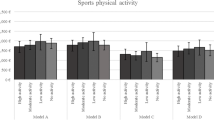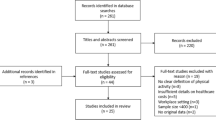Abstract
Objectives
To analyze the association between physical inactivity in different domains and direct public healthcare expenditures in adults and to identify whether the clustering of physical inactivity in different domains would contribute to increased public healthcare.
Methods
The sample composed of 963 adults randomly selected in a middle-size Brazilian city. Annual healthcare expenditure was estimated including all items registered in the medical records in the last 12 months prior to the interview. Habitual physical activity was estimated using Baecke questionnaire, which considers three components of physical activity (work, sports and leisure-time activities).
Results
Higher healthcare expenditures of medicines were associated with lower physical activity at work (OR 1.58 [1.06–2.35]), sport (OR 1.57 [1.12–2.18]) and physical inactivity in three domains (OR 2.12 [1.18–3.78]). Expenditures related to medicine (r = 0.109 [95 % CI 0.046–0.171]) and overall expenditures (r = 0.092 [95 % CI 0.029–0.155]) were related to physical inactivity, independently of age, sex, smoking, blood pressure and obesity.
Conclusions
Physically inactive subjects in different domains of physical activity have increased likelihood to be inserted at groups of higher healthcare expenditure.

Similar content being viewed by others
References
Abu-Omar K, Rütten A (2008) Relation of leisure time, occupational, domestic, and commuting physical activity to health indicators in Europe. Prev Med 47:319–323. doi:10.1016/j.ypmed.2008.03.012
Admiraal WM, van Valkengoed IG, L de Munter JS, et al (2011) The association of physical inactivity with Type 2 diabetes among different ethnic groups. Diabet Med 28:668–72. doi:10.1111/j.1464-5491.2011.03248.x
Arredondo A, Zuñiga A, Parada I (2005) Health care costs and financial consequences of epidemiological changes in chronic diseases in Latin America: evidence from Mexico. Public Health 119:711–720. doi:10.1016/j.puhe.2005.01.009
Arsenault BJ, Rana JS, Lemieux I et al (2010) Physical inactivity, abdominal obesity and risk of coronary heart disease in apparently healthy men and women. Int J Obes (Lond) 34:340–347. doi:10.1038/ijo.2009.229
Associação Brasileira de Empresas de Pesquisa (ABEP) (2010) Dados com base no Levantamento Sócio Econômico 2008—IBOPE. Disponible: www.abep.com.br. Accessed 10 March 2014
Baecke JAH, Burema J, Frijters JER (1982) A short questionnaire for the measurement of habitual physical activity in epidemiological studies. Am J Clin Nutr 36:936–942
Bahia L, Coutinho ES, Barufaldi LA et al (2012) The costs of overweight and obesity-related diseases in the Brazilan public health system: cross-sectional study. BMC Public Health 12:440. doi:10.1186/1471-2458-12-440
Balducci S, Zanuso S, Nicolucci A et al (2010) Anti-inflammatory effect of exercise training in subjects with type 2 diabetes and the metabolic syndrome is dependent on exercise modalities and independent of weight loss. Nutr Metab Cardiovasc Dis 20:608–617. doi:10.1016/j.numecd.2009.04.015
Bertoldi AD, Hallal PC, Barros AJD (2006) Physical activity and medicine use: evidence from a population-based study. BMC Public Health 6:224. doi:10.1186/1471-2458-6-224
Beunza JJ, Martínez-González MA, Ebrahim S et al (2007) Sedentary behaviors and the risk of incident hypertension: the SUN Cohort. Am J Hypertens 20:1156–1162. doi:10.1016/j.amjhyper.2007.06.007
Brazilian Society of Hypertension (2010) VI Diretriz Brasileira de Hipertensão Arterial. Rev Bras Hipertens 17:4
Christofaro DG, Ritti-Dias RM, Chiolero A et al (2013) Physical activity is inversely associated with high blood pressure independently of overweight in Brazilian adolescents. Scand J Med Sci Sports 23:317–322. doi:10.1111/j.1600-0838.2011.01382.x
Codogno JS, Fernandes RA, Sarti FM et al (2011) The burden of physical activity on type 2 diabetes public health care expenditures among adults: a retrospective study. BMC Public Health 11:275. doi:10.1186/1471-2458-11-275
Davis JC, Verhagen E, Bryan S et al (2014) Consensus Statement from the first Economics of Physical Inactivity Consensus (EPIC) Conference (Vancouver). Br J Sports Med 48:947–951. doi:10.1136/bjsports-2014-093575
de Sa TH, Garcia LM, Claro RM (2014) Frequency, distribution and time trends of types of leisure-time physical activity in Brazil, 2006-2012. Int J Public Health 59:975–982. doi:10.1007/s00038-014-0590-6
Fernandes RA, Zanesco A (2010) Early physical activity promotes lower prevalence of chronic diseases in adulthood. Hypertens Res 33:926–931. doi:10.1038/hr.2010.106
Fernandes RA, Freitas Junior IF, Cardoso JR et al (2008) Association between regular participation in sports and leisure time behaviors in Brazilian adolescents: a cross-sectional study. BMC Public Health 8:329. doi:10.1186/1471-2458-8-329
Fernandes RA, Christofaro DG, Casonato J et al (2010) Leisure time behaviors: prevalence, correlates and associations with overweight in Brazilian adults. A cross-sectional analysis. Rev Med Chil 138:29–35. doi:10.4067/S0034-98872010000100004
Hogan P, Dall T, Nikolov P (2003) Economic costs of diabetes in the US in 2002. Diabetes Care 26:917–932. doi:10.2337/diacare.26.3.917
Imbeault P, Makvandi E, Batal M et al (2013) Physical inactivity among francophones and anglophones in Canada. Can J Public Health 104:S26–S30
Katzmarzyk PT, Gledhill N, Shephard RJ (2000) The economic burden of physical inactivity in Canada. CMAJ 163:1435–1440
Kilsztajn S, Rossbach A, Câmara MB et al (2003) Serviços de saúde, gastos e envelhecimento da população brasileira. Rev Bras Estud Popul 20:93–108
Kolbe-Alexander TL, Conradie J, Lambert EV (2013) Clustering of risk factors for non-communicable disease and healthcare expenditure in employees with private health insurance presenting for health risk appraisal: a cross-sectional study. BMC Public Health 21(13):1213. doi:10.1186/1471-2458-13-1213
Lima MC, Barbosa MF, Diniz TA et al (2014) Early and current physical activity: relationship with intima-media thickness and metabolic variables in adulthood. Braz J Phys Ther 18:462–469
Lohman TG, Roche AF, Mertorell R (1988) Anthropometric Standardization Reference Manual. IHuman Kinectics Books, Champaign
Mann KD, Hayes L, Basterfield L et al (2013) Differing lifecourse associations with sport-, occupational- and household-based physical activity at age 49–51 years: the Newcastle thousand families study. Int J Public Health 58:79–88
Ozminkowski RJ, Ling D, Goetzel RZ et al (2002) Long-term impact of Johnson & Johnson’s Health & Wellness Program on health care utilization and expenditures. J Occup Environ Med 44:21–29
Saha S, Carlsson KS, Gerdtham UG et al (2013) Are lifestyle interventions in primary care cost-effective?–An analysis based on a Markov model, differences-in-differences approach and the Swedish Björknäs study. PLoS One 8:e80672. doi:10.1371/journal.pone.0080672
Williams ED, Eastwood SV, Tillin T et al (2014) The effects of weight and physical activity change over 20 years on later-life objective and self-reported disability. Int J Epidemiol 43:856–865. doi:10.1093/ije/dyu013
World Health Organization. Promoting physical activity for health—a framework for action in the WHO European region. Steps toward a more physically active Europe. Regional office for Europe, 2006 [consulted 2014 April 06]. Available at: http://www.euro.who.int/Document/NUT/Instanbul_conf_edoc10.pdf
Acknowledgments
The development of this work was partially supported by Brazilian Government through a PhD scholarship from CAPES and by the Brazilian Ministry of Science and Technology (CNPq) Projects no: 457448/2013-0, Project no: 401178/2013-7 and Project no: 476244/2013-7.
Conflict of interest
None.
Author information
Authors and Affiliations
Corresponding author
Rights and permissions
About this article
Cite this article
Codogno, J.S., Turi, B.C., Kemper, H.C.G. et al. Physical inactivity of adults and 1-year health care expenditures in Brazil. Int J Public Health 60, 309–316 (2015). https://doi.org/10.1007/s00038-015-0657-z
Received:
Revised:
Accepted:
Published:
Issue Date:
DOI: https://doi.org/10.1007/s00038-015-0657-z




